

The algorithm was also trained with a cellphone ringing in the background, and was still successful. It could be done, he says, perhaps using other techniques such as a knowledge of the spatial location of the numbers on the keyboard and relating that to the level of similarity in the sounds. Tygar believes the algorithm could be tweaked to recognise the delete key because people use it in a very distinctive way, often hitting up to 10 times in a row.īut numbers are harder as there are no forbidden combinations. There are limitations as to what the software can transcribe as it currently recognises only lower case letters and the “space”, “full stop”, “comma” and “enter” keys. But Schneier points out that this is unnecessary: “If I can read everything you type, I don’t care about your password.” Provided they were buried in a lot of good English, they found that about one in 20 times the software would get the password completely right, arriving at good approximations the rest of the time.Īlthough this does not sound very accurate, it is trivial for a hacker to try 20 different possible passwords. In an experiment, Tygar’s team found that even random assortments of characters, such as passwords, could also be estimated using the software. “It’s quite readable,” writes Edward Felten, a computer scientist at Princeton University in New Jersey, in his blog. These can then be used to transcribe further recordings.

The process is repeated and the result is a mapping with 92% of the characters correct.

Word options that have fewer than one-quarter of the characters corrected are then kept and the rest discarded, and the digram algorithm is reapplied. “Quite readable”īut Tygar’s team also applies spelling rules, which correct words from the transcription that do not make sense, such as “tre”, and grammar, which cuts out unlikely combinations such as “the a”. This technique alone maps 60% of the keystrokes correctly, the researchers claim. “Th” and “er” are common, “qu” is less common and “bf” is totally forbidden. This is done using a knowledge of which pairs of characters, known as “digrams” are common, less common and totally forbidden. The next step is to it map these classes to the different keys, using the probability of two letters being next to each other in a word.


 0 kommentar(er)
0 kommentar(er)
